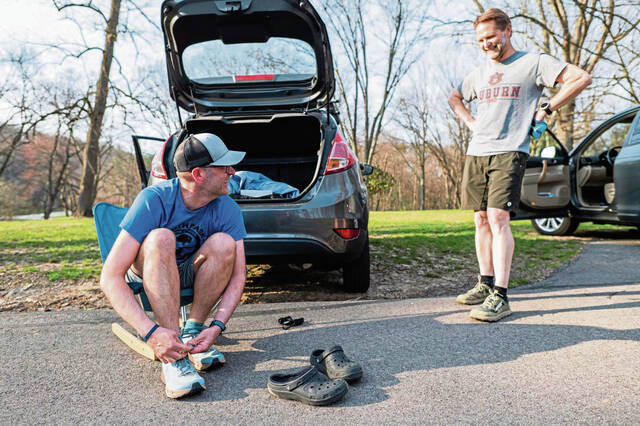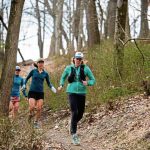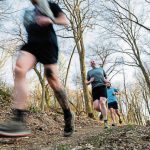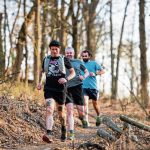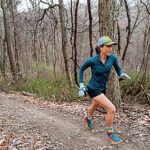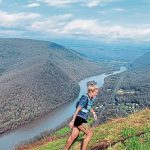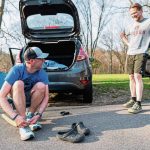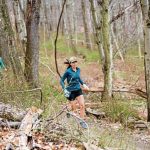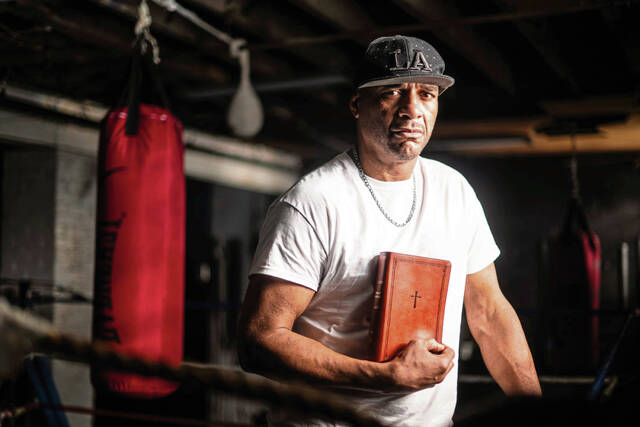South Hills resident Timmy Morgan, 36, was introduced to the sport of ultra running the same way a character in a movie discovers a destined journey.
It was a dark and stormy night.
Morgan and a friend had decided to set up camp after hiking along the Pacific Crest Trail for most of the day. It was around 9 p.m., rain was pouring down, when they heard rustling in the trees.
“This woman just kind of stumbles through our campsite,” Morgan said. “We started chatting with her and it turned out that she had been running about 40 miles a day with just a tiny little 12-liter backpack to drink from.”
The woman told Morgan that she intended to run the same amount of distance every day until she had traveled the entire trail.
“It was funny,” Morgan said. “I thought she was going to hang out for a bit because we had a fire going and it was nighttime and raining. She just got up and told us that she had to get 45 miles in that day and that she’d see us later.
”It just blew my mind that somebody could do that.”
After that chance encounter in the woods, the experienced 26.2 mile marathon runner could not stop thinking about what it would take to run farther. In 2019, he took the plunge and ran his first ultramarathon.
“It’s just been ‘full speed ahead’ ever since,” Morgan said.
Challenges, benefits
Ultramarathons are categorized as any race over 26.2 miles, but are most commonly presented as trail races ranging from 50 to 100 miles. Rather than being on a road like a traditional marathon, ultras normally take place in nature — over mountains, on forest trails or through deserts.
Many runners include hills or inclines in their training. Running up steep inclines is common in trail races — a 50-mile race usually includes at least 6,000 feet of elevation. The elevation helps define challenging races among members of the ultra community.
An ultramarathon can last several days, with runners stopping at checkpoints to quickly eat and drink before taking to the trail again. Runners are likely to spread out while they are racing, leaving competitors alone with their thoughts for hours on end.
Since engaging the sport, Morgan said he’s felt more in control of his life, and his confidence navigating everyday obstacles has increased.
“This sport is something that you carry with you into your everyday life,” Morgan said. “I almost use it as a tool and think, ‘OK, this thing is happening in my life, well, guess what? You’ve done some really hard things. It’s not as hard as that time you ran 100 miles.’ It helps put things into perspective”
Related:
• North Hills grad Margo Malone wins Pittsburgh Marathon• Thousands run city's bridges, hills and streets for the Pittsburgh Marathon
Research shows regular exercise can have a positive impact on depression, anxiety and attention-deficit/hyperactivity disorder. A recent study by the Harvard T.H. Chan School of Public Health found running for 15 minutes a day or walking for an hour reduces the risk of major depression by 26%.
Physical activity also has been shown to serve as a natural anti-anxiety treatment, relieving tension and stress. According to a recent Help Guide article, exercise boosts the brain’s dopamine and serotonin levels, both chemicals that affect focus and attention.
“The American College of Sports Medicine’s tagline has been, ‘exercise is medicine,’ for a long time,” said Dr. Jeanne Doperak, associate professor of sports medicine in the department of orthopedics at UPMC. “There is not one single disease process that you can not identify exercise as beneficial. Everything from diabetes to high blood pressure, heart disease, even mental health. Exercise touches us in so many ways.”
Morgan said the sport often attracts a certain personality type. He said many of the athletes he’s encountered have experienced something that nudged them toward ultramarathon running.
“I always say that nobody runs ultra because everything is OK in their life,” Morgan said. “It’s interesting to see the amount of people in recovery or who have been through some kind of trauma that find their way to the sport.”
After years of competition, Morgan has found a tight-knit community of runners and formed bonds that “will last a lifetime.” He theorizes the racing community is so close because all of the runners have hit low points in a race and have still made it out the other side.
Morgan’s friend and fellow runner, Don Knight, 41, agrees. He said that most runners find themselves alone on the trails for hours at a time during ultramarathons.
“The despair is unreal sometimes,” Knight said. “There are so many highs and lows over the long events. Whatever is going on in your head, you just have so much time to think about it.”
Accidental discovery
Knight, of Castle Shannon, said he stumbled upon the sport by accident. In 2014, he agreed to run a Tough Mudder mud run and obstacle course with a friend and fell in love with physical training. Knight worked his way through half-marathons and marathons until he reached his first ultra nine years ago.
Like many athletes dedicated to distance running, Knight said he finds himself trying to simulate the distance and terrain of the next course that he will run. He will often run at night and opt for long runs on rough terrain to acclimate his body to challenges during a race.
“You genuinely have to care about the event that you’re in,” Knight said. “After 10 or 12 hours of moving, the logical thing for your body to do is stop.”
Knight said his love for the sport is tied to the community of runners that come with it.
“The great thing about this sport, from an age perspective, is that it’s incredibly diverse,” he said. “We have runners in their early 20s and people in their mid 70s that are running with us. Hopefully I will go forever.”
Like Morgan, Knight saw a change in his life when he started dedicating his time to training. He said the sport introduced him to a new side of himself.
“I learned that I am capable,” Knight said. “Whatever the challenge, if I take it step by step, I can get through it. In business, for example, nothing seems as dire. It’s great for my mental health, and I’m just a better husband, father and employee when I run.”
Puppy love
Swissvale runner Megan Parke, 37, adopted a dog when she was in her 20s. The terrier-pitbull mix had energy to burn and enjoyed running with her through local parks.
Parke found she enjoyed the exercise as well. She was a frequent volunteer for the Humane Society and decided to sign up for an annual 5K hosted by the organization. She loved the experience and decided to keep running farther and farther.
“After I ran my first marathon, I was like, ‘That wasn’t bad, I think I could keep going,’” Parke said. “I didn’t really know about ultras then. I wasn’t in a running group. It was just me and my dog running. I signed up for this trail race just because it was something different. There were a few distances to pick from. I signed up for the 30K, not really realizing what I was getting into.”
Parke showed up to a 2015 summer race named Hell Hath No Hurry, and was immediately entranced with the environment, recalling a shirtless man covered in mud, eating jelly beans, as one of her first sights at the race.
Parke finished the race covered in sweat, mud and rain. She signed up for a 50K later that fall.
“I was like, ‘This is awesome,’” Parke said. “I loved it. I thought it was so much fun.”
Parke said she was at a low point during her 20s, fresh out of college and unsure of herself.
“Running kind of saved me,” Parke said. “It gave me confidence, and it gave me a sense of self that I never had. I was in a really bad relationship, and it gave me the confidence to leave and be independent. I had never had that.”
Parke has found herself in a “new normal.” She trains throughout the year, about 60 to 70 miles a week, including throughout a pregnancy.
“I ran until the week I gave birth,” Parke said. “I ran ultras when I was pregnant. Having that kept me true to myself and kept me sane.”
On the move
Lifelong runner April Miller, 25, said she’s realized she is happiest when she is moving and that discovery inspired her to leave the corporate world behind and open Adroit Athletics, a gym in Level Green.
Miller ran the King’s Highway Ultra in South Carolina earlier this year, in part to inspire her clients.
“I just want my people that come in the gym to know that they can do hard things,” Miller said. “I tell my clients every day that they can do it and that they can accomplish their goals. I wanted to lead by example.”
Miller said the race was a massive test.
“I like to think that I’m already pretty disciplined, but this was on another level,” Miller said. “I couldn’t just wing running 100 miles. With my baseline training, I could probably pull out a half marathon or even come in at the tail end of a marathon, but I really had to train for this.”
Miller said she felt empowered after finishing the race, and wants her clients to feel the same way every time they come through her gym doors.
She has also enjoyed meeting new friends from the ultra community.
“It really helped me grow a core group of friends that have the same mentality about being active,” Miller said.
‘Into your pain cave’
Ruth Werne, 51, of Gibsonia met a group of trail runners while training for a “bucket list” marathon and quickly became attached to the friendship and support they provided.
“It’s such a wonderful, strong community in the trail running groups,” Werne said. “It just kept me coming back. The community, the challenge and the beauty of being outdoors — those are the three things that really drew me in.”
Werne has perfected her training routine to fit each race she runs. For a 50-mile race, she works all aspects of her body and mind. She increases weekly mileage so her muscles are equipped to handle repetitive pounding and said preparing mentally is not much different.
“Ultra runners call it getting into your pain cave and finding your way out,” Werne said. “It’s good to get uncomfortable while you’re training so you can build that mental strength as well.”
She has used her mental strength more than once to get through a race.
“I want to reach my goal and have the accomplishment under my belt,” Werne said. “For me, thinking about that really helps me push through the pain and get to the finish line.”
Werne said running has helped her take action in her everyday routine.
“Sometimes you just have to accept the circumstances and let it roll,” she said. “You never know what the weather or the terrain is going to be like in a race, but you can control your hydration and nutrition. You can control your pacing. I think those are really analogous to working through personal life issues. You do what you can and accept what you can’t.”
The champion
Franklin Park’s Amy Nelson, 51, is an ultra runner with a cause.
As a champion for gender equity and female athletes, Nelson has found a supportive community through ultra running in Pittsburgh.
Nelson ran in junior and senior high school and was one of the fastest runners in junior high. However, her body began to mature in high school, and it affected her performance. Lacking proper coaching, Nelson felt it was time to hang up her cleats.
But she returned to running in 2010 and found races gave her an outlet for her competitive spirit. She began with road running and advanced to 5Ks, 5-milers, half marathons and marathons. She was hooked.
“I just kept going,” Nelson said.
Today, she works to change coaching models to better fit young female athletes such as her daughter.
“There’s no coaching in place for high school girls that educates them on puberty or development,” Nelson said. “A lot of girls end up quitting the sport. Women have access to the track, but the male-centric coaching model never changed, and a lot of times it follows female athletes into adulthood.”
Nelson engaged trail running through the Rachel Carson Trail Challenge, which led her to a running group, the North Park Trail Runners. As she began to train for the Carson Race, she fell in love with trail running.
“Looking back to when I first started ultra running, what appealed to me instantly was the fact that I could beat men because of the longer distance,” Nelson said.
Nelson discovered that while ultra running is diverse sport in age and ethnicity, there were far fewer female participants as compared to men. She works to change that as she serves on the board of directors for the Rachel Carson Trail Conservancy and as the founder of the Diversity, Equity and Inclusion council for the North Park Trail Runners.
Nelson champions female athletes through the annual Baker Ultra, which takes place in the Allegheny National Forest. In 2021, participation by women increased from 20% to 35%. This year, Nelson said half of the runners at the August race will be women — one of the highest female participation rates the race has seen in almost two decades.
“It’s huge,” Nelson said. “I’m thrilled. I celebrate the progress of other women in ultra running, and it gives me great satisfaction.”
Nelson said ultras have opened up a whole new world of what she is capable of and what she believes others are capable of accomplishing.
“I feel like more people should try it because it’s not as hard as it seems,” Nelson said. “With the right mindset and the right training, anyone could do it.”
Finding herself
Freeport native and former member of the United States National 24 Hour Race team, Jamie Donaldson, 48, had a similar description of ultramarathons.
Donaldson was a Division I runner at Penn State University. Her coach, Terry Jordan, had a strict rule against the distance athletes running extra-long distances and the marathon was one of the first things Donaldson did when she graduated. She began to research training and stumbled upon the ultramarathon world.
Over the past 18 years, Donaldson has run in hundreds of ultra races, her personal favorite being the 135-mile Badwater Ultra in California. She has run the race five times and holds the course record for women.
“Getting through a race depends on how you’re feeling,” Donaldson said. “You find out who you really are when you’re alone in the woods. You can either stop or keep going. I find myself thinking about how lucky I am to be in that moment and in those situations.”
Donaldson said she’s witnessed beautiful things on the trails such as shooting stars and animals in their natural habitat. She uses those experiences to push herself through the lows of a race. She now lives in Conifer, Colo., where she trains on state park trails.
The sport has afforded her the chance to visit South Korea, Italy and France with a national team to run in the 24-hour race, a more contained version of an ultramarathon.
“I discovered that I really can do anything I want to,” Donaldson said. “You have to understand that this is a sport that anyone can do. You just have to work up to it. Once you’re there, it’s not as scary as it seems.”








